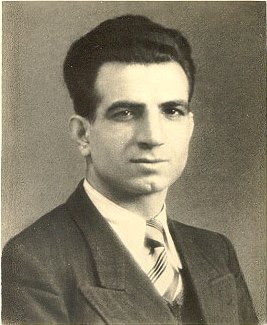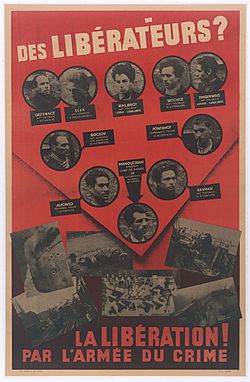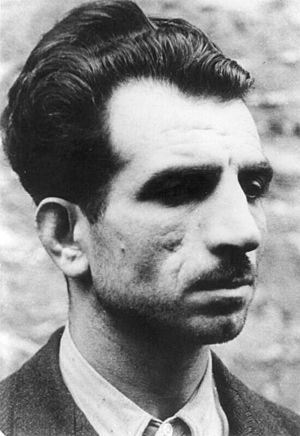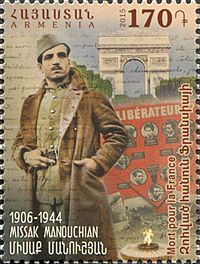Missak Manouchian facts for kids
Quick facts for kids
Missak Manouchian
|
|
|---|---|

Manouchian in the 1930s
|
|
| Born | 1 September 1906 |
| Died | 21 February 1944 (aged 37) Fort Mont-Valérien, Suresnes, Occupied France
|
| Cause of death | Execution by firing squad |
| Resting place | Ivry Cemetery, Ivry-sur-Seine |
| Other names | Michel Manouchian (francized) |
| Occupation | Trade unionist, poet, translator, political activist |
| Organization | FTP-MOI |
| Political party | French Communist Party (from 1934) |
| Movement | Labour movement, Anti-fascism, French Resistance |
| Spouse(s) | Mélinée (née Assadourian) |
Missak Manouchian (Western Armenian: Միսաք Մանուշեան; pronounced [misɑkʰ manuʃjɑn], 1 September 1906 – 21 February 1944) was a French-Armenian poet and communist activist. An Armenian genocide survivor, he moved to France from an orphanage in Lebanon in 1925. He was active in communist Armenian literary circles. During World War II, he became the military commissioner of FTP-MOI, a group consisting of European immigrants, including many Jews, in the Paris region which carried out assassinations and bombings of Nazi targets. According to one author, the Manouchian group was the most active French Resistance group. Manouchian and many of his comrades were arrested in November 1943 and executed by the Nazis in Fort Mont-Valérien on 21 February 1944. He is considered a hero of the French Resistance.
Contents
Early life
Manouchian was born on 1 September 1906 in Adıyaman, in Mamuret-ul-Aziz Vilayet, Ottoman Empire into an Armenian peasant family. His parents were killed during the Armenian genocide of 1915, but he and his brother managed to survive. In the early 1920s he settled in an Armenian General Benevolent Union-run orphanage in Jounieh, Lebanon, then a French protectorate. He acquired education there and in 1925 moved to France.
Eventually, Manouchian settled in Paris, where he took a job as a lathe operator at a Citroën plant. During this period he was self-educated and often visited libraries in the Latin Quarter. He joined the General Confederation of Labour (Confédération Générale du Travail, CGT), a national association of trade unions which was the first of the five major French confederations. In the early 1930s, when the world-wide economic crisis of the Great Depression set in, Missak Manouchian lost his job. Disaffected with capitalism, he began earning a meager living by posing as a model for sculptors.
Political and literary career
In 1934, Manouchian joined the French Communist Party. From 1935 to 1937 he edited the Armenian-language left-wing weekly newspaper Zangou, named after a river in Armenia. The newspaper was anti-fascist, anti-Dashnak, anti-imperialist and pro-Soviet.
Manouchian wrote poetry and, with an Armenian friend who used the pseudonym of Séma (Kégham Atmadjian), founded two communist-leaning literary magazines, Tchank ("Effort") and Mechagouyt ("Culture"). They published articles on French literature and Armenian culture. The two young men translated the poetry of Baudelaire, Verlaine, and Rimbaud into Armenian, making many of these works available in Armenian for the first time. Both Manouchian and Séma enrolled at the Sorbonne to audit courses in literature, philosophy, economics, and history.
The following year, he was elected secretary of the Relief Committee for Armenia (HOC), an organization associated with the MOI (Immigrant Workforce Movement). At a meeting of the HOC in 1935, he met Mélinée Assadourian, who became his companion and, later, his wife.
World War II
When the Second World War broke out in September 1939 Manouchian, as a foreigner, was evacuated from Paris. He found work in the Rouen area, again as a lathe-operator. After the defeat of June 1940, he returned to Paris to find that his militant activities had become illegal. (French authorities had banned the Communist Party as early as September 1939.) On 22 June 1941, when the invasion of the Soviet Union by the Nazis began, Manouchian was arrested by the occupying Germans in an anti-communist round-up in Paris. Interned in a prison camp at Compiègne, by the efforts of his wife Mélinée Assadourian, he was released after a few weeks without being charged.
Manouchian became the political chief of the Armenian section of the underground MOI, but little is known about his activities until 1943. In February of that year, Manouchian transferred to the FTP-MOI, a group of gunmen and saboteurs attached to the MOI in Paris.
Manouchian became the leader of the FTP-MOI in June/August 1943, replacing Boris Holban. Manouchian assumed command of three detachments, totaling about 50 fighters. The Manouchian group is credited with the assassination on 28 September 1943, of General Julius Ritter, the assistant in France to Fritz Sauckel, responsible for the mobilization and deportation of labor under the German STO (Obligatory Work Service) in Nazi-occupied Europe. (The attack was made by the partisans Marcel Rayman, Léo Kneller, and Celestino Alfonso.) The Manouchian groups carried out almost thirty successful attacks on German interests from August to November 1943. Charles Aznavour and his family were members of the Manouchian resistance group, and were recognized after the war for rescuing Jews and Armenians from Nazi persecution.
Arrest and execution
On 16 November 1943, the collaborationist French police forces arrested the Manouchian group at Évry-Petit Bourg. His companion, Mélinée, managed to escape the police.
Manouchian and the others were tortured to gain information, and eventually handed over to the Germans' Geheime Feldpolizei (GFP). The 23 were given a 1944 show trial for propaganda purposes before execution. Manouchian and 21 of his comrades were shot at Fort Mont-Valérien near Paris on 21 February 1944. The remaining group member, Olga Bancic, was deported to Stuttgart and beheaded there in May 1944.
In his last letter to his widow, Mélinée, Manouchian said that he forgave everyone except the one who betrayed us to save his skin and those who sold us. "There was consensus that they were betrayed by one of their number, Joseph Davidovitch (fr), who was arrested and tortured by the Nazis (before being released and shot by the Resistance). But some survivors also felt the French Communist Party had sacrificed the unit by refusing to smuggle vital Jewish combatants out of Paris after the French police began to tail them."
Photographs of French Resistance agents facing a firing squad of Nazi officers were discovered in December 2009, and Serge Klarsfeld identified them as Manouchian and his group members. The photographs began being permanently exhibited at Fort Mont-Valérien in June 2010.
L'Affaire Manouchian
In June 1985, a television documentary by Mosco Boucault with the historian Stéphane Courtois working as a consultant entitled Des terroristes à la retraite (Terrorists in Retirement) was aired. The documentary started an intense dispute over the identity of the informer who betrayed Manouchian and the rest of groupe Manouchian in 1943. In the documentary, Mélinée Manouchian accused Boris Holban of being the informer. In the 1986 book L'Affaire Manouchian by Philippe Robrieux, Holban was accused of being a member of an "ultra-secret special apparatus" within the PCF that took its orders from the Kremlin and that Holban had betrayed the groupe Manouchian on orders from Moscow. The French journalist Alexandre Adler, in a series of articles in the Socialist newspaper Le Matin, defended Holban, arguing that he was not in Paris in the fall of 1943 and thus was not in a position to know the address of Manouchian or anyone else in his group. Adler drew attention to a 1980 article in the Romanian journal Magazin istoric by the FTP-MOI intelligence chief Cristina Luca Boico, where she mentions that Holban was leading a maquis band in the Ardennes in November 1943 and had not been in Paris for some time. L'Affaire Manouchian was finally settled in the 1990s when French police records were opened, revealing that Joseph Davidowicz, a resistance fighter who was arrested and then released by the Gestapo, was the informer who betrayed Manouchian. Davidowicz was later killed by fellow resistance members, who accused him of spying for the Germans.
Recognition
Following World War II, Armenians were perceived in France positively "solely in the reflective light of Missak Manouchian, who played an important role in the French anti-Nazi resistance." Manouchian is a prominent figure in the bilateral relations between Armenia and France. In 2022 Benoît Payan, the Mayor of Marseille, called for interning Manouchian at the Panthéon in Paris.
In 2007, an exhibition dedicated to Manouchian was held at the Musée Jean Moulin in Paris in the scope of the Year of Armenia in France. On 21 February 2014, on the 70th anniversary of the execution of Manouchian and his group, a commemoration ceremony was held at Fort Mont-Valérien. Notable attendees included French President François Hollande, Armenian Foreign Minister Eduard Nalbandyan and prominent French-Armenian singer Charles Aznavour. On 13 March 2014, the Missak Manouchian Park was opened in central Yerevan, the Armenian capital, in attendance of Presidents Serzh Sargsyan and Hollande.
On 5 March 1955, a street named for the Manouchian Group (fr) was dedicated in the 20th arrondissement of Paris.
In 1978, a statue of Manouchian sculpted by Ara Harutyunyan was opened in the military cemetery of Ivry-sur-Seine, Paris.
A commemorative plaque was installed on 22 February 2009 at 11 rue de Plaisance, in the 14th arrondissement of Paris. The old hotel at this address was the last home shared by Manouchian and his wife, Mélinée.
In February 2010, busts of Manouchian were inaugurated in a Marseille, in a square named after him, and in Issy-les-Moulineaux.
Due to his communist ideology, Manouchian was immediately recognized as a hero in the Soviet Union. Soviet Armenian author Marietta Shaginyan described him as an "example of an Armenian who preserved his nationality, and at the same time became a class-conscious worker and a militant communist in his adopted country." Russian poet Sergei Shervinsky hailed him in a 1956 Ogoniok article as a "Fighter, Worker, Poet". A school in Yerevan, Armenia—founded in 1947—was named for Manouchian in 1963.
Possible pantheonization
In January 2022 a campaign was launched by Nicolas Daragon, mayor of Valence, Drôme, and Jean-Pierre Sakoun, president of Comité Laïcité République, and others to move Manouchian's ashes to the Panthéon. Supporters included Katia Guiragossian, a great-niece of Missak and Mélinée Manouchian, sociologist Nathalie Heinich, historian Denis Peschanski, and others. It has further gained the support of the mayors of Paris and Marseille Anne Hidalgo and Benoît Payan, former French ambassador to Armenia Jonathan Lacôte, and MPs from various parties. In March 2022 Europe 1 reported that French President Emmanuel Macron is planning pantheonization of Manouchian. A close presidential adviser was quoted as saying: "This file is at the top of the pile." Le Monde reported Macron met with supporters of the campaign on March 30, 2022 at the Élysée Palace and several days later, Macron said of Manouchian: "I think he is a very great figure and that makes a lot of sense." Early 2024 is being discussed the likely date of the ceremony in commemoration of the 80th anniversary of his execution or the Normandy landings.
See also
 In Spanish: Missak Manouchian para niños
In Spanish: Missak Manouchian para niños
- Affiche Rouge (Red Poster)






